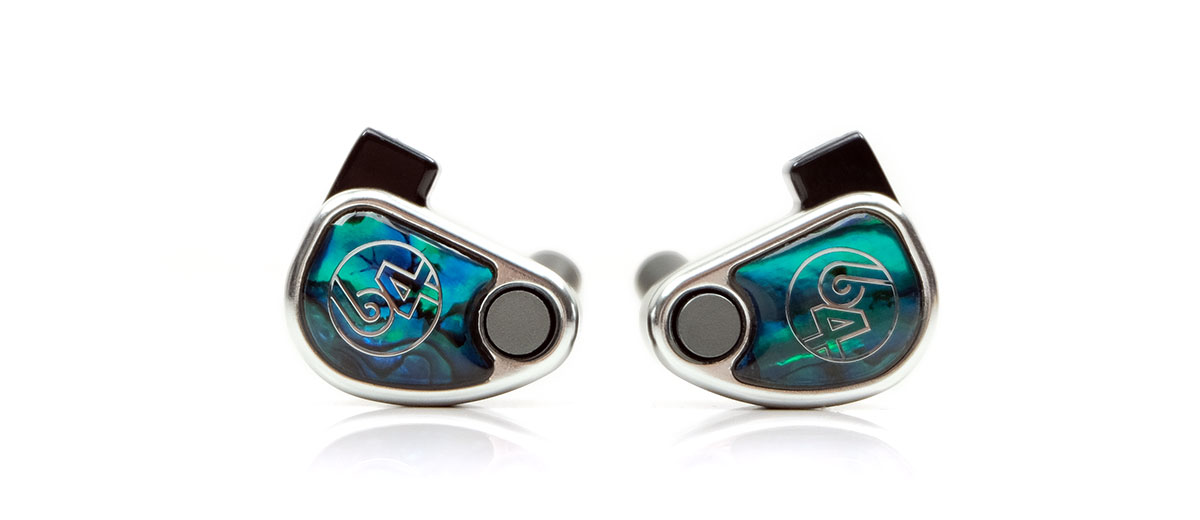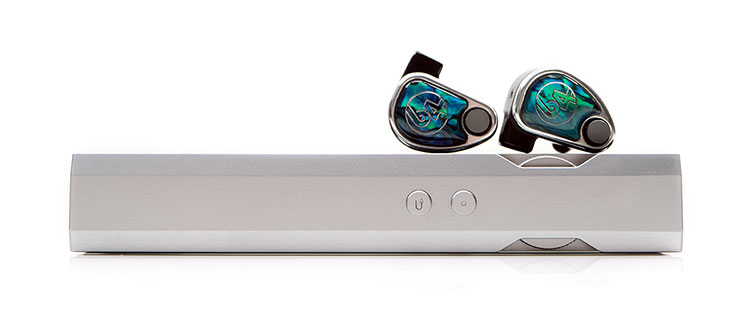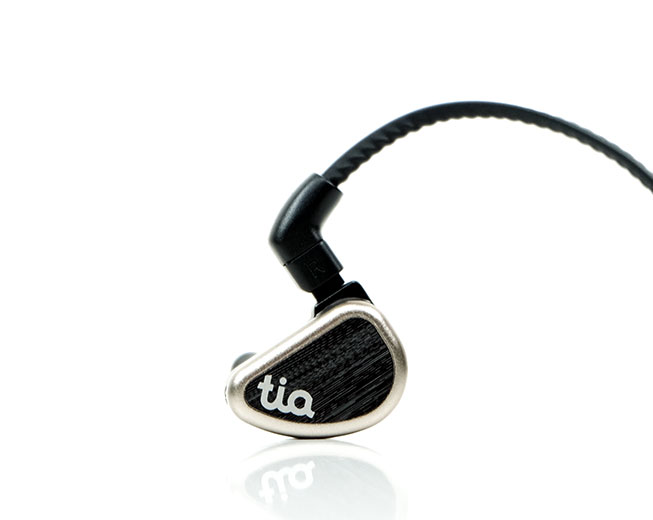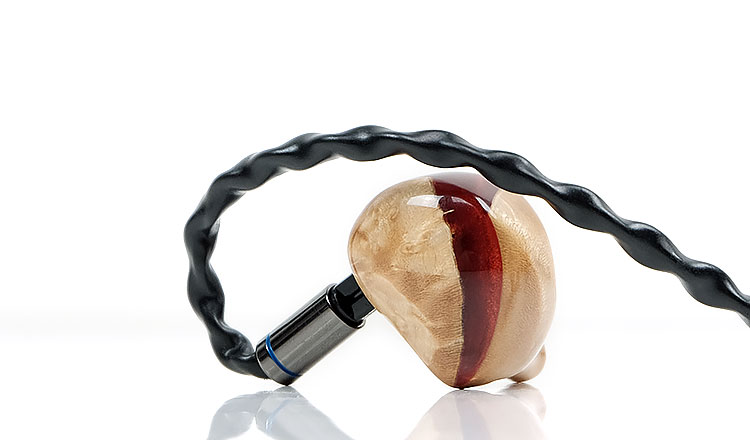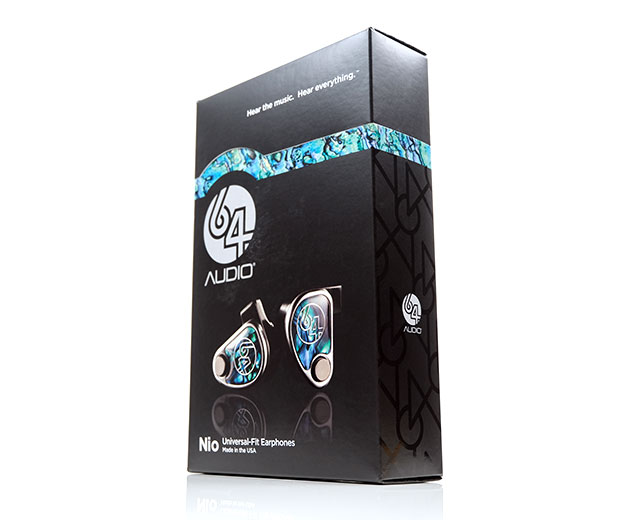Sound Impressions
Summary
What I always find indicative of a 64 Audio tuning is the eye for detail, the technical capability, and not just the overall tone. Yet, with the Nio it is the overall tone that will grab you first, followed by the gradual realization, that damn, the technical capability of the Nio is really rather good.
No doubt, the Nio is more colored than the Trio or older models such as the U18t and if one had to place it, then it is indeed closer to the A12/U12t series in terms of warmth, at least with the m20 and m15 modules.
With the mX module inserted, it is an entirely different monitor with a more balanced or neutral bass tuning that shifts the listening experience to the mids and lower-treble but still retains a very natural sound.
With the m15, the Nio has a smooth, bass-weighted response with a neutral to slightly forward midrange, a rich vocal delivery, and a fairly relaxed treble response. It is closer to a mild l-shape than a U or V curve.
The Nio m15 is tuned for listening rather than analyzing and works a charm with modern rock and pop but not something I would say is clinical enough for classical and big-sounding scores that need plenty of headroom.
The m20 Nio has a serious kick in it’s rear though a slightly different one from the impressive bass response of the Trio. This one sounds fuller, weightier, and with more mid-bass warmth and a little upper bass bloom compared to the cooler and punchier tone of the Trio.
Response Tweaks
Comparing the 3 filters the m15 and m20 are much closer bedfellows in terms of a core response curve with that sub-to-mid-bass weighting being dominant. The mX really drops that curve from 1k down to 20Hz by ever-increasing amounts though there is still a slight lift from 50-100Hz which gives it that natural tone and prevents it from sounding too shallow.
From 1kHz onwards there is not a huge amount of difference in terms of FR adjustments between the 3 modules. That means all 3 have a steady rise from 1-5k for mids presence but it is still secondary to the bass amplitude and a lower bump from 5k upwards.
With the mX, the mids and treble of the Nio sound cleaner and clearer but that is more to do with the bass weight and warmth being pushed down rather than any significant FR change.
Timbre
The Nio timbre is warm and smooth throughout the FR with a bit of roundness to notes through to 1k, especially on lower-mids instrumental notes.
The low-end has all the classic hallmarks of a dynamic driver with plenty of gritty texture and a slow rate of decay. Overall, the Nio 9mm delivers a nice planted bass fundamental with plenty of mid-bass warmth that allows instruments to sound both full-bodied and powerful.
Treble has a slow fade beyond 5-6k that only serves to enhances that euphonic and slightly creamy tone in the mids. Vocals are wet, rich, and sibilant free but not dull sounding either. There is enough of a mids lift to keep them relatively vibrant and engaging which I like personally as a vocals guy.
Despite the treble fade and lack of headroom, the BA drivers, especially the tia high, actually do a great job retaining a high degree of clarity with a very refined level of articulation beyond 1k and a solid black background. Smooth it maybe but not smoothed over as they say.
Staging
The Nio delivers some excellent depth and a surprising level of width and instrumental separation with it. The staging 3-dimensionality is ok, but not quite as stretched front to back as something like the Trio with its more elevated vocal performance and cleaner highs.
Vocals have enough of a lift to prevent them from sounding veiled, however, it is really with the mX module that they properly come to the fore along with percussion presence.
The bass does a little softness to it with the m15 and more so with the m20 module. So, whilst the Nio bass quantity level is high and the depth excellent it is really only with the mX module do you get some necessary tightness and control on the decay levels to get a bit more perceptible level of instrumental separation and air beyond.
Headroom might be the weak link to the Nio’s staging quality in terms of a treble extension with outright sparkle, at least compared to the Trio and I am pretty sure also the Fourte.
However, what does impress me is that air is not a huge issue with the Nio’s performance. It is darker than some of their other monitors but not something you would ever class as veiled. This is a treble for a more relaxing listening experience.
Silver Premium Cable
This is a good pairing for those that enjoy the m15 and m20 module weight and power but want something a little less rounded and sweeter sounding.
The effect is pretty easy to make out with a little bit more dynamic range and better higher frequency reproduction as well as a lighter note in the mids. I suspect the resistance levels are lower on this cable allowing more detail to shine.
As a result, the silver premium cable shaves off a bit of that fullness into the mids and allows a bit more treble to shine into the Nio’s timbre. Notes have an ever so slightly leaner quality to them compared to the stock cable but a more accurate tone overall.
With the m20 and m15 cable that is an advantage as it improves midrange instrumental separation and imaging along with it giving it a more balanced feel without any loss in bass power.
Staging is now more 3D-like for me with the silver premium cable. Softer-sounding cues have a little bit more bite and come across as cleaner making them easier to pick out.
Synergy
Efficiency
The Nio is rated at 6Ω and 105db SPL which makes it relatively easy to drive but not a super-sensitive monitor like a Solaris or Andromeda. The dynamic driver is the lowest common denominator here with regards to that 105dB SPL and like its bigger sibling, it drives up the current demand a little more.
Noise is really not an issue on the Nio. Pretty much all DAPs we tested delivered a nice black background including the Lotoo PAW Gold Touch, the HiBy R8, and the LP P6 both balanced and unbalanced. Even the Hifiman R2R2000 in both output modes was very quiet and with plenty of playable volume up to around 20 in low gain.
Low-Z skew is also not an issue for HiBy R6 users out there with that 10Ω output impedance because of the Nio LID impedance tech. It sounds true to its sound signature regardless of the module used with the only coloration coming from the R6’s normal tuning output.
Pairings
The Nio pairs immaculately with a lot of the neutral-sounding sources we tested it with. In fact, those cleaner sources with excellent dynamic range sounded ideal, especially if you can opt for the silver premium cable and a balanced connection.
Going balanced really enhances the channel separation on the Nio pushing the stage out wide and improving imaging by a large amount on sources such as the Hifiman R2R2000 black and the FiiO M15. The R2R2000 was perhaps the punchiest I had heard the Nio with the best level of layering on the low-end from the tested sources.
If you opt for the stock on the 3.5mm then the Lotoo PAW Gold Touch with its equal output rating single or balanced is also ideal in terms of excellent dynamic range, a black background. It has a peppy treble tuning also which keeps the Nio top-end working optimally.
One left-field choice, however, is the Cayin N3Pro‘s single-ended Ultralinear mode on its tube operational mode output with the silver premium cable. This really brought out an excellent vocal performance on the Nio, far more so than I had anticipated. It also has less bass weight which might be a factor in the Nio’s corresponding vocal sweetness and clarity.
If you prefer to keep that heavier warmer tone then the LP P6 is ideal. What I like about it over other smoother sounding DAPs such as the HiBy R8 is the level of detail in its note texture which is a bit better than delta-sigma alternatives.
The R8 gives a similar weighted response but it has a little too much ‘shine’ on the texture and too smooth whereas the P6 injects a lot more detail. It is still a relatively soft attack despite the weight but it does offer a more satisfying level of clarity sub-1k.
Select Comparisons
64 Audio Trio
$2299
Technical
This is our last 64 Audio review, a universal triple driver monitor that is priced quite a bit higher but features a complete, three-part tia system for the drivers rather than a single tia high inside the Nio.
The Nio complements this with a further 6 drivers using a single 9mm dynamic driver for the lows, 6 BA for the mids, and 1 BA for the mid-highs. I would guess the Trio also uses that 9mm for the lows and a single BA for the mids but all 3 are tubeless.
Both have shared tech in the form of apex and LID. However, the apex m15 module inside the Trio is fixed as non-changeable internally rather than an external swappable filter opening as you get on the Nio. That means isolation is fixed at -15dB whereas with the Nio you can chop and change from -10dB using the mX up to -20dB using the m20.
In terms of efficiency, their impedance rating SPL are quite similar at 6 Ω105dB for the Nio and 5.5Ω, 104dB for the Trio. Both are what I would loosely describe as medium efficiency monitors and should not be subject to any pervasive hiss from DAPs with higher single-ended noise floors such as the FiiO M15, HiBy R8, and Luxury & Precision’s P6.
Design
Although the finishing differs both monitors share a very similar form factor. The one big difference is the Nio’s use of the interchangeable apex module system on the front of the faceplate whereas the Trio is fixed with m15 inside the shell. Both have ports or vents for the dynamic driver to breathe though it’s on the rear of the Nio and o the front of Trio.
Other more subtle differences include a slightly slimmer nozzle base and taller socket stems on the Nio. Aside from that, it is really the finishing that stands out.
The Nio’s striking abalone plate and chrome fenders look like an upgrade in design confidence to me over the subdued black, charcoal, and silver pattern of the Trio. This is a preference call because I know some will prefer the more executive look of the Trio but it is the Nio patterned blue tone that will catch the eye first.
Both monitors come with the Premium cable ($129.99 version) as stock with 2-pin 0.78mm connectors so the performance from the cables will be the same.
Performance
To get a fairly accurate idea of where these two differ, at least on a technical basis, I compared the Nio using the m15 module which is the same internal module inside the tia Tio.
Timbre
Well, the first thing that leaps out is how futile the driver count wars were with both sounding as competent as each other. However, you can clearly pick out the differences between the two with the Nio delivering a more liquid, warmer timbre, and the Trio offering a natural but slightly brighter and cleaner performance.
That is contextual because the Trio is not a bright monitor per see, but rather just incredibly articulate in the mids and highs. The Nio takes a more relaxed approach in the highs so it is not as airy and that rounds out its timbre a bit more and allows the low-end warmth to take priority for instrumental and vocal tones.
Bass Tuning
The Trio and Nio low-ends are both sub-bass emphasized but here you will find perhaps a little more separation in the Trio low-end to mids transition because of a steeper mid-bass to lower-mids drop as well as a bigger 1-3k bump.
The Nio has a gentler drop into the lower-mids and more of a sustain into the mid-bass which is where it pulls that richer warmer tone. The resulting sound is denser, heavier but also a little more liquid on the attack with more bloom. It is very much a smooth but weighted tone but some might find the Trio punchier and more distinct.
Staging
The Trio’s cut into the lower-mids, stronger 1-3k bump, and a more pronounced upper treble give it a cleaner tone in the midrange, more vocal forwardness, and better headroom. Staging thus sounds more stretched from front to back on the Trio but more separated from top to bottom with that low-end separation.
The Nio’s staging is perhaps a little more linear through the mids from 2-5k. It has a bump just not as pronounced so bass weight and presence are a little more dominant when busy. Vocals, full-bodied and euphonic as they are sound comparatively relaxed positionally speaking.
Unique Melody MEST
$1699
Technical
The MEST is also a hybrid monitor with an 8-driver count, instead of the 9 inside the Nio. However, the configuration is vastly different. The MEST uses a bone conduction driver as well as two Sonion electrostatic drivers on top of BA and dynamic. That is a fusion of 4 different drivers.
The precise configuration is a slightly larger 10mm dynamic driver for the lows, 2 BA for the Mid-highs, 2BA for the Highs, and 2 EST for the Ultra-highs. The bone conduction driver adds an additional layer across the mids and highs of the MEST.
This compares to the Nio’s relatively simpler hybrid configuration of a single 9mm dynamic driver for the lows, 6 BA for the mids, and 1 BA for the mid-highs with a single tia high.
Note, all MEST drivers are using the more traditional tubing and a 5-way crossover for phase control. The Nio uses the tia tubeless design for the highs and regular tubing for the rest of the driver setup with an integrated 4-way passive crossover.
The MEST is rated at 14Ω and 114dB SPL compared to the Nio’s 6Ω and 105dB rating and as such a little bit easier to drive but not a huge gap, around 5 – 6 steps on a Lotoo PAW Gold Touch in low gain. Neither are terribly sensitive to hiss using an unbalanced output.
Design
Since the MEST sample here is a custom there is a big difference in isolation and comfort levels with the MEST isolating better and fitting perfectly.
However, the MEST does lack the Nio apex, tia, and LID style of technology so there are no filter modules, nor is there any impedance compensation on the MEST. The MEST has a fixed vent on the outer shell for the dynamic driver to breathe as well as tubing for all drivers except the bone conductor.
Both use 0.78mm 2-pin connectors though the MEST is a 2-pin protruding socket whereas the Nio is the more uniform flush socket fitting which I tend to prefer.
Both have good stock cables with the MEST using a silver-plated copper wire, 26AWG in size wrapped in a relatively translucent jacket showing off the mix of silver and darker coppery/brown tones of the wiring. The Nio’s Premium cable might be a smaller gauge but it also uses an SPC wire and both are 4-core.
One thing to note the supplied MEST cable is about the same quality and finish as the Silver Premium cable from 64 Audio so it is heavy but less prone to kinks and lower for microphonics.
Performance
With the m15 inside the Nio, the sound signature is much denser, not as airy as the MEST presentation but with significantly more bass weight and bloom. The MEST comes across as fairly natural sounding but comparatively speaking a brighter cleaner tone.
Bass
The MEST’s FR is gentler in terms of bass bumps and valleys and whilst it is sub-bass biased it drops and hangs low from around 200Hz to around 500-600HZ and then rises up to 3k.
The Nio is quite a different tuning with far more sub-bass elevation right up into the mid-bass and then a gradual drop to 1k. The bass response is probably the biggest difference, not that MEST is linear, not at all, but rather it is more subtle than the ‘big-ticket’ response of the Nio.
Mids
The lower-mids instrumental presence on the MEST is quite good due to that lower-mids rise but it lacks the warmth and powerful bass fundamental of the Nio. Instead, it has a focus on clarity and crunch and it does benefit from a little bit more treble presence creeping down into the mids timbre to help it with that.
The Nio sounds more rounded with less odd-harmonic infusion so it is full-bodied and quite firm, particularly with male rock vocals that sound smooth but also quite planted. The key difference is clarity versus power where the lighter weight of the MEST tuning delivers a bit more articulation and separation compared to the guttural impact of the Nio.
Treble
Up top, the MEST has a bit more lower-to-mid treble emphasis and a bit more energy in the upper treble also. It is not overly peppy actually, but it does have more sparkle and air than the Nio’s darker tuning.
The MEST has more dryness in the vocal timbre compared to the liquid delivery of the Nio and whilst it has a bit more space for vocals to breathe it is a little less forgiving than the Nio. The Nio delivers a very rich and smooth vocal tone, especially female vocals but will sound more rounded and not quite as open.
mX Module
The mX module brings the Nio a bit closer to the MEST type of sound. It drops the bass response significantly which in turn allows the mids to breathe and come to the fore a lot more. You do get an enhanced perception of instrumental and vocal clarity with the mX and a bit more air in the mids as a result. I would hesitate to say reference but certainly a lot more natural.
The top-end does not change significantly, perhaps a bit more air, but it remains relatively relaxed forgiving a bit more of a mid-to lower-treble focused performance compared to the MEST which articulates the upper treble and sub-bass a bit more.
The timbre on the Nio is still relatively warmer than the MEST but the gap is not as huge using the mX module compared to the m15 and the m20.
Noble Audio Zephyr
$1450
Technical
We reviewed the Zephyr a few weeks back and the sample we have is the more expensive prestige universal version which retails for $2300 but you can get the standard universal version for $1450. The only difference is the materials and finishing with the internals and sound signature being the same.
The Zephyr is a much simpler configuration compared to the Nio using only 3 drivers, much like the Trio. The configuration is a single 10mm dynamic driver for the lows and 2 Knowles BA drivers with a three-way system for the mids and highs.
The Nio is more complex with an integrated 4-way passive crossover stitching together one 9mm dynamic driver for the lows, 6 BA for the mids, 1 BA for the mid-highs, and a single tia high driver.
The Nio also uses apex exchangeable filter modules for pressure adjustment, (and sound signature changes), LID for impedance balancing as well as the tia tubeless high driver design. Noble has never really opened up about how they design their monitor internals but they do not use electrical crossovers and prefer to designate a system instead of an actual electrical crossover.
The Zephyr has no official rating but Noble creations are never more than 30Ω or less than 105dB SPL. In our testing, I found them to be very similar in terms of output volume matching with perhaps the Zephyr just being ever so slightly louder. Neither are hiss-sensitive monitors with DAPs that have typically high noise floors.
Design
It is a bit hard to judge as I have yet to see the universal version of the Zephyr to compare with the Nio properly. However, the Prestige maple burl with a resin finish gives off a beautiful warm vibe with a mix of grained tan and wine tones.
I actually think the Nio abalone blue is a very nice attractive contrast to the warm but it’s not consistent over the entire shell so it’s faceplate only with a more subdued black and chrome fender and main shell. Just remember though there is a significant price difference on the SRP to get that Prestige design.
The Zephyr is deeper or taller than the Nio and whilst not hugely wider it will create the impression of a much bigger shell. Noble does like very long nozzles so they will insert a little deeper with the supplied stock tips. Overall, the Nio feels a little bit lighter and comfier in the ear as a result.
Both are 0.78mm 2-pin sockets but the cables are very different. The Zephyr uses 1.2m 8-core 26AWG OCC wire in what seems to be an FEP or PVC jacket compared to the smaller gauge SPC inside a very light black jacket.
The Noble is big, heavy but very quiet for microphones and very resistant to kinks. It is a bit of a monster but an excellent performer. The Nio Premium cable’s 4-core might lose out a little in terms of dynamic range and likely has more resistance but it is lighter and the comfier of the two to wear.
Performance
Modules
The Zephyr tuning is a lot closer to the Neo performance using the mX module. The m15 and m20 modules color the presentation much more to the low-end so both of those modules will give a much thicker and more powerful performance, a richer midrange but less lower-treble presence.
I also think the separation on all 3 modules is a little bit better than the Zephyr which is not quite as expansive. The Zephyr tends to give you that raw live concert feel where it’s in front of you, loud and proud. Whereas the Nio, plus any module, sounds a bit more like a studio chamber, more precise, blacker background, with a bit more staging width and separation.
Low-end
The Zephyr low-end has a bit of sub-bass fade with more mid-bass emphasis which roughly translates to how the mX treats the low-end also. With the m20 and to a lesser extent the m15, the low-end of the Nio vastly out rumbles the Zephyr. It is like comparing 2 different Nio’s to the Zephyr and perhaps there lies the advantage of the Nio in itself.
Vocals
Vocals are a bit further forward on the Zephyr and they sound more emphatic and vibrant also with that pepper treble creeping in. They have a beautifully natural sound to them with just a slight odd-harmonic coloration for timbral accuracy.
The Nio’s vocals are smoother, more liquid, and just a bit more relaxed sounding. However, they do have a bit more clarity and composure with a blacker background that helps a lot with their imaging.
Treble
The one area that does slightly outperform all the Nio modules is the Zephyr treble which does have a bit more bite and presence around the 5-7k and for me, the Nio just slightly dips there taking the sting out of possible sibilance but also just a bit more bite out of percussion. As a result, the Zephyr sounds more energetic for percussion and higher-pitching vocal presence.
Our Verdict
I rarely ever get a duff product from 64 Audio and the Nio is no different. It is perhaps the most ‘weighted’ or darkest sound I have heard from them to date but the technical capability of the Nio is excellent with a very enjoyable modern bass-heavy sound and a smooth almost euphonic timbre without any dreaded veil.
The inclusion of all 3 relevant modules is a big statement for me. With the m15 and m20, all bassheads will get something satisfying out of the Nio but if you are on the fence then the mX module will balance that out with a far more audiophile quality to it.
Having a tuning choice is a powerful pitch but more so when one of them, the mX module, delivers an almost completely different listening experience.
I do recommend the silver premium cable. I understand that it will add to the overall cost factor but it does tease out treble and mids clarity a lot better adding some necessary harmonic balance to the mids and staging experience from the Nio.
Overall, the 64 Audio Nio a very enjoyable listening experience with some excellent technical capability and a high degree of flexibility when it comes to synergy with the inclusion of the apex modules.
64 Audio Nio Specifications
- Driver Type/Count: Eight precision balanced armature drivers and one dynamic driver
- Driver Configuration: 1 tia high, 1 high-mid, 6 mid, 1 dynamic low
- Frequency Response: 10Hz – 20kHz
- Sensitivity: 105db dB/mW
- Impedance: 6Ω @1kHz
- Crossover: Integrated 4-way passive crossover
- Isolation: -10db w/ mX module, -15dB w/ m15 module, -20dB w/ m20 module




